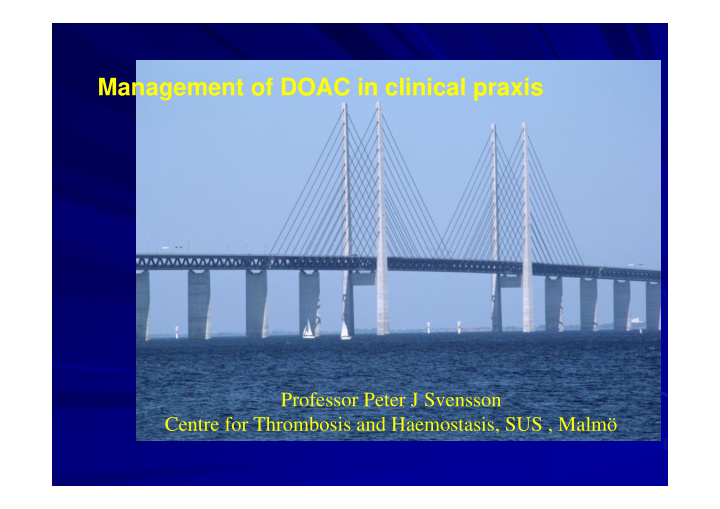



Management of DOAC in clinical praxis Professor Peter J Svensson Centre for Thrombosis and Haemostasis, SUS , Malmö
Disclosures for [Peter J Svensson] • ACCP Guidelines 2012 • Bayer • Auricula (Chairman) • Boeringer Ingelheim • Pfizer / BMS
Prevalence of atrial fibrillation > 2.5 % in the general population Andersson et al JIM 2012, SBU 2013 april Friberg et al JIM 2013
Indications for OAC Atrial fibrillation > 80% VTE 10% Mechanical heart valves 5% Other 5% Increase of OAC with 5-10% per year 30 % is over the age of 80 years among patients with OAC Auricula 2014
Different laboratory tests (coagulation-tests) 1.Tests that are availbale in most laboratories, easy to perform and semiquantitative for use in ie emergency situations. The test should indicating supra or subtherapeutic anticoagulation 2. Test that gives quantitative results to determine the anticoagulant effect (drug level) 3 (HPCL-tandem mass spectrometry) J Throm Haemost 2013; 11: 756-60
1. Screening ‐ 1. Screening ‐ 2.Methods for 2.Methods for Substance Substance methods methods measuring/ measuring/ group group affected affected monitoring monitoring Thrombin APTT time (TT) Direct FIIa ‐ inhibitors ECT INR Karin Strandberg 2013
1. Screening ‐ 1. Screening ‐ 2.Methods for 2.Methods for Substance Substance methods methods measuring/ measuring/ group group affected affected monitoring monitoring APTT Direct Anti Xa ‐ FXa ‐ activity inhibitors INR Karin Strandberg 2013
Effect of FII and FX inhibitores on coagulation assays FII FII FX FX Effect Measuring Effect Measuring PT (INR) + ‐ (+) ? APTT ++ Qualitative + Qualitative Thrombin time +++ Qualitative ‐ ‐ Diluted TT ++ Quantitative ‐ ‐ ACT + ? + ? Ecarin clotting ++ Quantitative time Anti ‐ IIa assay ++ Quantitative ‐ ‐ (chromogenic) Anti ‐ Xa assay ‐ ‐ ++ Quantitative (chromogenic) J Throm Haemost 2013; 11: 756-60
How I handle DOAC in my clinical practice Anticoagulation clinic; 12.000 patients DOAC >3000 patients Start on DOACs Information (nurse 15- 20 minutes) Basic laboratory tests ( Hemoglobin, platlets and coagulation test APTT INR and kidney function eGFR) First year on DOAC eGFR 3, 6 and 12 months after start. Bergman et al Thromb Res. 2013
How I handle DOAC in my clinical practice Strategies to minimize the risk of bleeding Review the patients risk factors; age, weight, renal function Prescribe the dose of DOAC that is recommended Have a strategy for discontinue DOAC before surgery and how to resume DOAC after surgery Local guidelines / Education!!!!
DOAC – broad terapeutic window Broad terapeutic window Thrombosis Bleeding Dabigatran ~ 50-200 ng/ml Rivaroxaban ~ 25-400 ng/ml Apixaban ~ < 300 ng/ml ?? NOAC Dose, concentration or intensity of anticoagulation FDA
Steady State
Peak and Trough
Peak and Trough Cuker. J Thrombosis and Thrombolysis 2015
• Is kidney function important to measure and monitor for DOAC ??
CKD Chronic Kidney Disese CKD*- GFR* Description (mL/min/1,73 m 2 ) stadium No CKD Normal ≥ 90 1 Normal with i.e. proteinuria ≥ 90 2 Mild 60–89 3 Moderate 30–59 4 Severe 15–29 Kidney failure 5 <15 or dialysis ESRD* *GFR = glomerulär filtrationshastighet; Njurskada definieras som t ex mikroalbuminuri; CKD = chronic kidney disease; ESRD = end-stage renal disease (terminal njursvikt) 1. Koro CE, et al. Clin Ther 2009; 31: 2608–17. 2. National Kidney Foundation. Am J Kidney Dis 2002;39(suppl1):S1–S266.
Prevalence of kidney dysfunction in patients with AF • eGFR = estimated glomerular filtration rate • MDRD = modified diet in renal disease • LM = Lund –Malmö • eGFR(MDRD) = 175 × (p ‐ Cr/88.4) − 1 . 154 × age − 0.203 × 0.742 (if female) × 1.212 (if Afro ‐ American) Jönsson et al. Thromb Res. 2011 Oct;128(4):34
Effect on DOAC plasma level.
Effect on DOAC plasma level increase or decrease
One possible way to handle a clinical situation
Trough plasma concentrations of dabigatran: concomitant treatment dabigatran 110 mg BID and dronedarone 400 mg BID Median trough concentration of dabigatran 150 mg bid without concomitant dronedarone was 93 ng/ml (10th to 90 th percentile 39.8-215), in the RE-LY substudy
What is the size of the ” bridging ” issue Peri-Procedual Bleeding and Thromboembolic Events with Dabigatran compared to Warfarin: Results from the RE-LY trail A total of 4591 (25%) patients underwent at least one invasive procedure during the study. Pacemaker/ICD 10% Dental procedure 10% Different Diagnostic procedures 10% Cataract removal 9.5% Colonoscopy 9% Hip or knee Replacement 6% Circulation 2012; 126:343-48
Kidney function and half life of DOAC eGFR Dabigatran Apixaban Edoxaban Rivaroxaban ( m l/ m in) >80 12-17h 12h 10-14h 5-9h (yngre) 11-13h (äldre) 60-80 14h 14h 8.6h 8.5h 30-60 18h 17h 9.4h 9h 15-30 28h 17h 17h 9.5h ≤ 15 No data No data No data N data
Patients undergoing a planned intervention or surgery • Low risk 1 day • High risk 2 days • fX , eGFR 15 ‐ 30, high risk 3 days • fII, eGFR 15 ‐ 30, högrisk 4 days Douketis et al-J Thromb Haemostas Online October 2015
Clinical situation were DOAC theoretically could be measured • Bleeding • Emergancy surgery • Body weigt (low or high) • Renal failure • Trauma • Trombolysis • Antidot
Sweden warfarin vs DOAC
Conclusion and Callenges Older and more complex patients with more co-morbidity Kidney function Follow – up important (register) How to interpretate test results (compare to LMWH) i.e. dos adjustment Establish reference interval
Malmö Centre for Thrombosis and Haemostasis THANKS
Recommend
More recommend